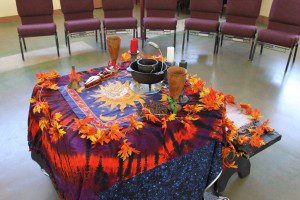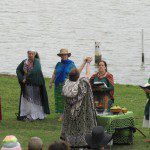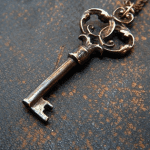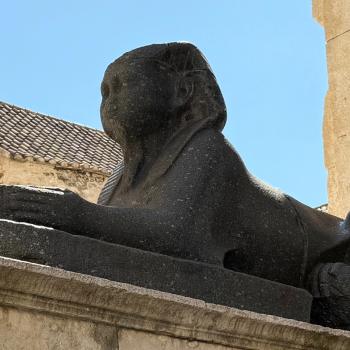This Sunday I’ll be speaking at Pathways UU Church in Euless, Texas. The service is titled “The Art of Wild Wisdom” – it’s a brief look at Druidry both ancient and modern, and a look at the love of Nature as a religious impulse. For the Story for All Ages, I’ll be telling the story of the Reformed Druids of North America.
Here’s a video of me telling this story at Denton UU earlier this year:
This is a wonderful story and it illustrates a very important religious principle: what you do matters more than what you believe. Intention is important, but intention alone doesn’t control the outcome.
From the RDNA website, here’s an excerpt from a 1965 flyer by David Frangquist at Carleton College:
Reformed Druidism has its beginning at Carleton College in the spring of 1963 as a protest to the college’s requirement that all students attend a certain number of religious services or meetings. One of the ways of fulfilling the requirement was by attending services of one’s own religion. The Reformed Druids of North America proposed to test the degree of freedom permitted under this clause.
If religious credit were granted, the religious requirement could be exposed as totally ineffective. If, on the other hand, credit were denied, the college could be charged with bigotry. The initial attitude of the college was, “If we ignore them, they’ll go away.” But the RDNA not only refused to go away, it grew, acquiring an advisor, and becoming a registered college organization.
In June, 1964, the religious requirement was repealed. Even though the Druids rejoiced at this triumph, they recognized that their job was not over. For many members the movement had come to represent a valuable part of their spiritual lives.
The Reformed Druids never intended to create a religion – or a spirituality or a philosophy or anything similar. Their goal was to trap Carleton College into ending its requirement that students attend chapel services by creating a pseudo-religion. But they knew if they created a parody – if they created the Church of the Flying Spaghetti Monster – the college would simply smack them down. It had to look and sound and feel like a real religion.
So they built on the myth of the Druids as priests of Nature. They invoked real gods and goddesses. They revived real festivals – I have to wonder why they included Midsummer but skipped the equinoxes, but they’re not wrong, and they included the four fire festivals. They held their services outdoors. They added as many ancient Celtic touches as they could find.
They did it right! They may not have intended to create a real religion, but that’s exactly what they did. Is it any wonder that two years after RDNA began “For many members the movement had come to represent a valuable part of their spiritual lives”?
Underneath the myths and doctrines and rituals and regalia of any religion lies an operating system, an interface between the human and the divine, a bridge between the ordinary world and the Otherworld. This is “religious tech.” Like a cell phone, you don’t have to understand it, you just have to be able to use it. But if you want your spiritual cell phone to work you’ve got to have working tech. Use the tech properly – as the Reformed Druids did – and you’ll get good results.
Not every religion uses the same tech – the operating system of Buddhism is very different from the operating system of Evangelical Christianity. That’s not a Mac vs. PC difference – that’s a phone vs. television difference. They both share some general similarities, but they’re really different devices for different purposes.
If you want a good religion you have to have good, working religious tech. You can invent it yourself, or you can build on the existing tech of current religions and on the restored tech of our pagan ancestors.
Guess which one has a better chance of working?
The same thing is true in magic. Jason Miller of the Strategic Sorcery blog has this post called DIY in Magic is Overrated. Go read the whole thing for yourself, but here are a couple excerpts:
A long time ago a teacher told me that the value of making something yourself cannot be over-stated. Therein lies the problem, I think it can be over-stated, and often is.
It is these absolutes that are the problem. They fail to take anything other than the power of creation into account. There are other considerations.
Jason says those other considerations include the power of tradition, the power of craftsmanship, and the need to grow beyond what you already are.
 Some of the religious and magical tech Pagans use include meditation, visualization, energy work, ritual (which includes various lower-level tech), invocations and offerings. Doing these things is easy – doing them well is not. You can figure it out on your own, but why spend years on trial and error when you can learn from someone who’s been there and done that? You can learn it faster and more surely, which means you can spend less time figuring it out and more time on doing whatever it was you wanted to do in the first place.
Some of the religious and magical tech Pagans use include meditation, visualization, energy work, ritual (which includes various lower-level tech), invocations and offerings. Doing these things is easy – doing them well is not. You can figure it out on your own, but why spend years on trial and error when you can learn from someone who’s been there and done that? You can learn it faster and more surely, which means you can spend less time figuring it out and more time on doing whatever it was you wanted to do in the first place.
Practice long enough and deeply enough and eventually you’ll run out of how-to books. Eventually you’ll run out of teachers. But before you start marching across the desert without a map, check into what our ancestors did. Mainstream scholarship can be very helpful. Read history, anthropology, archeology, psychology, biology… Maybe you won’t find exactly what you’re looking for, but odds are good you’ll find a place to start, or a key step, or a critical idea you hadn’t considered before.
So if you want to take your practice deeper, if you’re ready to move beyond feel-good spirituality, remember that
The Reformed Druids of North America never intended to found an order. But they used some good religious tech, and this year they celebrated their 50th anniversary. Religious tech works – use the best.
















